An Autonomous Distributed Coordination Strategy for Sustainable Consumption in a Microgrid Based on a Bio-Inspired Approach
Abstract
1. Introduction
- -
- Specification of an autonomous MG management approach and self-regulating demand and load generation through emergent control mechanisms, enabling MG self-organization.
- -
- Definition of an emergent control approach based on the RTM, applicable to both the generation and demand sides. Traditionally used for task assignment problems, this is the first application of the RTM in coordination and distributed control contexts.
- -
- Development of a scheme to balance generated and demanded power, combining load from the main network and renewable sources, and controlling controllable loads and excess energy storage.
- -
- Schematization of a methodology to apply our emergent control approach in MGs in any context. Following this methodology, an MG autonomy can be specified.
2. Related Work
3. Theoretical Framework
3.1. Response Threshold Model (RTM)
3.2. System Modeling
3.2.1. Photovoltaic System
3.2.2. Energy Storage System (ESS)
3.2.3. Controllable Loads
- Type I: this type consists of various residential loads, like refrigerators, air conditioners, water heating, etc. These loads can be interrupted or controlled (e.g., for reducing demand).
- Type II: this type contains battery storage, Vehicle-to-Grid, etc., and it can be charged from or discharged to the grid (it can inject power into the grid). Furthermore, this type of load can be controlled to accommodate its grid needs.
- Type III: this type includes the rest of the appliances schedulable, which can be deferred for a suitable moment. There are diverse appliances (phone chargers, microwaves, washing machines, tumble dryers, dishwashers, vacuum cleaners, etc.).
4. Design of an Emergent Control System Based on the Response Threshold Model
4.1. Distributed Control Architecture of a Microgrid
4.2. Specification of the MAS
- Solar radiation.
- Demand.
- Weather conditions.
- SOC.
- Energy costs.
| Algorithm 1. Behavior of each agent based on the RTM. |
| Input: local/external variables |
Procedure:
|
| Output: state of the agent (OFF/ON) |
4.3. Emergent Control System for a Microgrid
4.3.1. Photovoltaic Agent
4.3.2. Energy Storage Agent
4.3.3. Main Grid Agent
4.3.4. Load Agent
5. Experiments
5.1. Experimental Protocol
- Integral square error (ISE): This metric penalizes errors with higher values more severely than those with lower values. It is particularly useful for indicating overshoots and aggressive control, which are common following a disturbance.
- Integral Absolute Error (IAE): Unlike ISE, IAE does not differentiate between positive and negative errors. It is frequently used for online controller tuning and is suitable for typical operations and non-monotonic step responses.
5.2. Energy Scenarios
5.2.1. Case Study 1: Solar Energy in Remote Rural Locations
- Setting to modulate the instantaneous stimulus signal such that it allows variations of the accumulated stimulus in the order of tenths, to prevent overflow.
- Estimating preliminary values for and with simulations indicating the temporal trends of the stimulus and the threshold as shown in Figure 3B, with the dotted gray line representing the orientation of the signals. The adjustment is made using Equation (30) as the objective function.
- The space around the previously obtained initial values of and is explored. For that, a sweep is made of between 1 × 10−5/100 × 10−5 and between 1 × 10−5/10 × 10−5, obtaining the following values: = 2.1 × 10−4 and = 1 × 10−5 and a = 0.0641.
5.2.2. Case Study 2: Variable Solar Power in Remote Rural Areas
5.2.3. Case Study 3: Coordination between Energy Supply Agents
5.2.4. Case Study 4: Storage System with Failures
5.2.5. Case Study 5: Storage System Failure and Restoration
5.2.6. Case Study 6: Normal Operation of the MG with Constant Demand
5.2.7. Case Study 7: Normal Operation of the MG with Variable Consumption
5.2.8. Case Study 8: Energy Price Variability
5.3. General Discussion
5.4. Qualitative Comparison with Previous Works
- Context of Distributed Control: one criterion is whether the study is within the context of distributed control.
- Energy Problem Involving Both Supply and Demand: another criterion is whether the study addresses the energy problem involving both supply and demand simultaneously.
- Consideration of New Agents: lastly, we consider if the study incorporates dynamically new agents, such as new renewable energy sources.
6. Conclusions
Author Contributions
Funding
Data Availability Statement
Conflicts of Interest
Disclaimer
Nomenclature and Abbreviations
| Subscripts | |
| i | For agents/individuals |
| j | For tasks, j = {PV, ESS, UG} |
| Variables | |
| Response threshold | |
| s | Stimulus |
| q | Activation probability |
| Nact | Quantity of active entities |
| N | Quantity of entities that may be active in the colony |
| Instant stimulus | |
| Portion of entities of type i doing task j | |
| Maximum active power output PV [W] | |
| Solar radiation [kw/m2] | |
| Ambient temperature [°C] | |
| Terminal voltage of the battery [V] | |
| Battery state of charge at t [%]. | |
| The effective value of the discharge current [A] | |
| Total active power generated [W] | |
| Error in the supply-demand [W] | |
| Generated active power by the renewable systems [W] | |
| Main grid active power [W] | |
| Active power in the energy storage system [W] | |
| Total energy consumption or demand [W] | |
| Power consumed by controllable loads [W] | |
| Power consumed by uncontrollable loads [W] | |
| Comfort cost | |
| Market cost | |
| Abbreviations | |
| DER | Distributed energy resources |
| DRL | Deep Reinforcement Learning |
| EP | Energy pool |
| PEU | Power exchange unit |
| EMS | Energy Management System |
| ES | Energy system |
| ESS | Energy storage system |
| HES | Hybrid energy systems |
| LC | Controllable loads |
| LNC | Non-controllable loads |
| MAS | Multiagent Systems |
| MASINA | Multiagent Systems for Integrated Automation |
| MG | Microgrid |
| PV | Photovoltaic |
| RES | Renewable Energy Systems |
| RTM | Response Threshold Model |
| RL | Reinforcement Learning |
| UG | Utility grid |
| WECS | Wind energy conversion systems |
| Parameters | |
| α | Scale factor that measures the efficiency in performing the task |
| δ | Increase in the stimulus’s intensity per unit of time |
| β | Learning rate |
| Forgetting rate | |
| Conversion efficiency of the PV array | |
| Area of the PV array [m2] | |
| Circuit voltage [V] | |
| Internal resistance of the battery [Ω] | |
| Polarization constant | |
| Attenuation factor of the instantaneous stimulus function (fs) | |
References
- Ray, P.K.; Mohanty, S.R.; Kishor, N. Small-signal analysis of autonomous hybrid distributed generation systems in presence of ultracapacitor and tie-line operation. J. Electr. Eng. 2010, 61, 205–214. [Google Scholar] [CrossRef]
- Moghaddas-Tafreshi, S.; Jafari, M.; Mohseni, S.; Kelly, S. Optimal operation of an energy hub considering the uncertainty associated with the power consumption of plug-in hybrid electric vehicles using information gap decision theory. Int. J. Electr. Power Energy Syst. 2019, 112, 92–108. [Google Scholar] [CrossRef]
- Anvari-Moghaddam, A.; Rahimi-Kian, A.; Mirian, M.S.; Guerrero, J.M. A multi-agent based energy management solution for integrated buildings and microgrid system. Appl. Energy 2017, 203, 41–56. [Google Scholar] [CrossRef]
- Ahmethodzic, L.; Music, M. Comprehensive review of trends in microgrid control. Renew. Energy Focus 2021, 38, 84–96. [Google Scholar] [CrossRef]
- Aguilar, J.; Garcès-Jimènez, A.; Gallego-Salvador, N.; de Mesa, J.G.; Gomez-Pulido, J.; Garcìa-Tejedor, À. Autonomic Management Architecture for Multi-HVAC Systems in Smart Buildings. IEEE Access 2019, 7, 123402–123415. [Google Scholar] [CrossRef]
- Rahman, M.S.; Orchi, T.; Saha, S.; Haque, M.E. Cooperative Multiagent Based Distributed Power Sharing Strategy in Low-Voltage Microgrids. IEEE Trans. Ind. Appl. 2020, 56, 3285–3296. [Google Scholar]
- Bonabeau, E. Fixed Response Thresholds and the Regulation of Division of Labor in Insect Societies. Bull. Math. Biol. 1998, 60, 753–807. [Google Scholar] [CrossRef]
- Shahgholian, G. A brief review on microgrids: Operation, applications, modelling, and control. Int. Trans. Electr. Energy Syst. 2021, 31, e12885. [Google Scholar] [CrossRef]
- Liu, Z.; Xiang, T.; Wang, T.; Mu, C. Cooperative Optimization Strategy for Distributed Energy Resource System using Multi-Agent Reinforcement Learning. In Proceedings of the IEEE Symposium Series on Computational Intelligence, Orlando, FL, USA, 5–7 December 2021; pp. 1–6. [Google Scholar]
- Zhou, Q.; Shahidehpour, M.; Paaso, A.; Bahramirad, S.; Alabdulwahab, A.; Abusorrah, A. Distributed Control and Communication Strategies in Networked Microgrids. IEEE Commun. Surv. Tutor. 2020, 22, 2586–2633. [Google Scholar] [CrossRef]
- Hu, M.; Xiao, F.; Wang, S. Neighborhood-level coordination and negotiation techniques for managing demand-side flexibility in residential microgrids. Renew. Sustain. Energy Rev. 2021, 135, 110248. [Google Scholar] [CrossRef]
- Zhou, X.; Zhou, L.; Chen, Y.; Guerrero, J.; Luo, A.; Wu, W.; Yang, L. A microgrid cluster structure and its autonomous coordination control strategy. Int. J. Electr. Power Energy Syst. 2018, 100, 69–80. [Google Scholar] [CrossRef]
- Areekkara, S.; Kumar, R.; Bansal, R. An Intelligent Multi Agent based Approach for Autonomous Energy Management in a Microgrid. Electr. Power Compon. Syst. 2020, 49, 18–31. [Google Scholar] [CrossRef]
- Harmouch, F.; Krami, N.; Hmina, N. A multiagent based decentralized energy management system for power exchange minimization in microgrid cluster. Sustain. Cities Soc. 2018, 40, 416–427. [Google Scholar] [CrossRef]
- Kofinas, P.; Dounis, A.I.; Vouros, G.A. Fuzzy Q-Learning for multi-agent decentralized energy management in microgrids. Appl. Energy 2018, 219, 53–67. [Google Scholar] [CrossRef]
- Chouikhi, S.; Merghem-Boulahia, L.; Esseghir, M.; Snoussi, H. A Game-Theoretic Multi-Level Energy Demand Management for Smart Buildings. IEEE Trans. Smart Grid 2019, 10, 6768–6781. [Google Scholar] [CrossRef]
- Xu, X.; Jia, Y.; Xu, Y.; Xu, Z.; Chai, S.; Lai, C.S. A Multi-Agent Reinforcement Learning-Based Data-Driven Method for Home Energy Management. IEEE Trans. Smart Grid 2020, 11, 3201–3211. [Google Scholar] [CrossRef]
- Arnone, D.; Croce, V.; Paternó, G.; Rossi, A.; Emma, S.; Miceli, R.; Di Tommaso, A.O. Energy Management of Multi-carrier Smart Buildings for Integrating Local Renewable Energy Systems. In Proceedings of the 5th International Conference on Renewable Energy Research and Applications, Birmingham, UK, 20–23 November 2016; Volume 5, pp. 20–23. [Google Scholar]
- Aguilar, J.; Giraldo, J.; Zapata, M.; Jaramillo, A.; Zuluaga, L.; Moreno, M.R. Autonomous Cycle of Data Analysis Tasks for Scheduling the Use of Controllable Load Appliances using Renewable Energy. In Proceedings of the 2021 International Conference on Computational Science and Computational Intelligence (CSCI), Las Vegas, NV, USA, 15–17 December 2021. [Google Scholar]
- García, M.; Aguilar, J. Emergent control in the context of industry 4.0. Int. J. Comput. Integr. Manuf. 2021, 35, 247–262. [Google Scholar] [CrossRef]
- Du, Y.; Lu, X.; Wang, J.; Lukic, S. Distributed secondary control strategy for microgrid operation with dynamic boundaries. IEEE Trans. Smart Grid 2019, 10, 5269–5282. [Google Scholar] [CrossRef]
- Chai, J.; Peng, Y. Coordinated Power Control for Islanded DC Microgrids Based on Bus-Signaling and Fuzzy Logic Control. In Proceedings of the 2nd IEEE Conference on Energy Internet and Energy System Integration, Beijing, China, 20–22 October 2018. [Google Scholar]
- Arwa, E.O.; Folly, K.A. Reinforcement Learning Techniques for Optimal Power Control in Grid-Connected Microgrids: A Comprehensive Review. IEEE Access 2020, 8, 208992–209007. [Google Scholar] [CrossRef]
- Zheng, Y.; Li, S.; Tan, R. Distributed Model Predictive Control for On-Connected Microgrid Power Management. IEEE Trans. Control Syst. Technol. 2018, 26, 1028–1039. [Google Scholar] [CrossRef]
- Kyriakou, D.G.; Kanellos, F.D. Optimal Operation of Microgrids Comprising Large Building Prosumers and Plug-in Electric Vehicles Integrated into Active Distribution Networks. Energies 2022, 15, 6182. [Google Scholar] [CrossRef]
- Escobar, L.M.; Aguilar, J.; Garcés-Jiménez, A.; De Mesa, J.G.; Gomez-Pulido, J. Advanced Fuzzy-Logic-Based Context-Driven Control for HVAC Management Systems in Buildings. IEEE Access 2020, 8, 16111–16126. [Google Scholar] [CrossRef]
- Bonabeau, E.; Sobkowski, A.; Theraulaz, G.; Deneubourg, J. Adaptive Task Allocation Inspired by a Model of Division of Labor in Social Insects. Biocomput. Emergent Comput. 1997, 36–45. [Google Scholar]
- Yamada, K. Specialization in Swarm Robotics using Local Interactions. Int. J. Eng. Res. Technol. 2016, 5, 103–108. [Google Scholar] [CrossRef]
- Teruya, D.; Indurkhya, B.; Maksaki, T.; Nakajo, H. Autonomous Distributed System Based on Behavioral Model of Social Insects. In Proceedings of the International Conference on Parallel and Distributed Processing Techniques and Applications, Las Vegas, NV, USA, 30 July–2 August 2018; pp. 289–295. [Google Scholar]
- Ding, Z.; Huang, Y.; Yuan, H.; Dong, H. Introduction to Reinforcement Learning. In Deep Reinforcement Learning; Springer: Berlin/Heidelberg, Germany, 2020; pp. 47–123. [Google Scholar]
- Antonanzas-Torres, F.; Urraca, R.; Polo, J.; Perpiñán-Lamigueiro, O.; Escobar, R. Clear sky solar irradiance models: A review of seventy models. Renew. Sustain. Energy Rev. 2019, 107, 374–387. [Google Scholar] [CrossRef]
- Mousavi, S.M.; Nikdel, M. Various battery models for various simulation studies and applications. Renew. Sustain. Energy Rev. 2014, 32, 477–485. [Google Scholar] [CrossRef]
- Shen, J.; Jiang, C.; Li, B. Controllable Load Management Approaches in Smart Grid. Energies 2015, 8, 11187–11202. [Google Scholar] [CrossRef]
- Aguilar, J.; Cerrada, M.; Hidrobo, F. A Methodology to Specify Multiagent Systems. In Proceedings of the Agent and Multi-Agent Systems: Technologies and Applications, Wroclaw, Poland, 31 May–1 June 2007; Volume 4496, pp. 92–101. [Google Scholar]
- Aguilar, J.; Besembel, I.; Cerrada, M.; Hidrobo, F.; Narciso, F. Una Metodología para el Modelado de Sistemas de Ingeniería Orientado a Agentes. Intel. Artif. Rev. Iberoam. Intel. Artif. 2008, 12, 39–60. [Google Scholar]
- Domański, P.D. Control Performance Assesment: Theoretical Analyses and Industrial Practice; Springer: Berlin/Heidelberg, Germany, 2020. [Google Scholar]
- Bergstra, J.; Bengio, Y. Random Search for Hyper-Parameter Optimization. J. Mach. Learn. Res. 2012, 13, 281–305. [Google Scholar]
- Morales, L.; Ouedraogo, C.; Aguilar, J.; Chassot, C.; Medjiah, S.; Drira, K. Experimental comparison of the diagnostic capabilities of classification and clustering algorithms for the QoS management in an autonomic IoT platform. Serv. Oriented Comput. Appl. 2019, 13, 199–219. [Google Scholar] [CrossRef]
- Yousif, M.; Ai, Q.; Wattoo, W.; Jiang, Z.; Hao, R.; Gao, Y. Least cost combinations of solar power, wind power, and energy storage system for powering large-scale grid. J. Power Sources 2019, 412, 710–716. [Google Scholar] [CrossRef]
- Zheng, K.; Schmitt, J.; González, A.; Fettweis, G. Self-organized Allocation of Dependent Tasks in Industrial Applications. In Proceedings of the IEEE International Conference on Autonomic Computing and Self-Organizing Systems (ACSOS), Washington, DC, USA, 27 September–1 October 2021; pp. 170–176. [Google Scholar]
- Sánchez, M.; Aguilar, J.; Cordero, J.; Valdiviezo-Díaz, P.; Barba-Guamán, L.; Chamba-Eras, L. Cloud Computing in Smart Educational Environments: Application in Learning Analytics as Service. In New Advances in Information Systems and Technologies; Rocha, Á., Correia, A., Adeli, H., Reis, L., Mendonça Teixeira, M., Eds.; Springer: Berlin/Heidelberg, Germany, 2016; Volume 444, pp. 993–1002. [Google Scholar]
- Wetzels, W.; van Dam, K.; Geerdink, T.; Meerman, H. Decision Making on Regional Energy Transition. Models, Tools and Approaches; Technical Report: TNO2020P10053; ESTRAC: Guiche, France, 2019; Available online: https://research.hanze.nl/ws/files/35101462/TNO2020_P10053_Decision_making_on_regional_energy_transition.pdf (accessed on 1 September 2023).
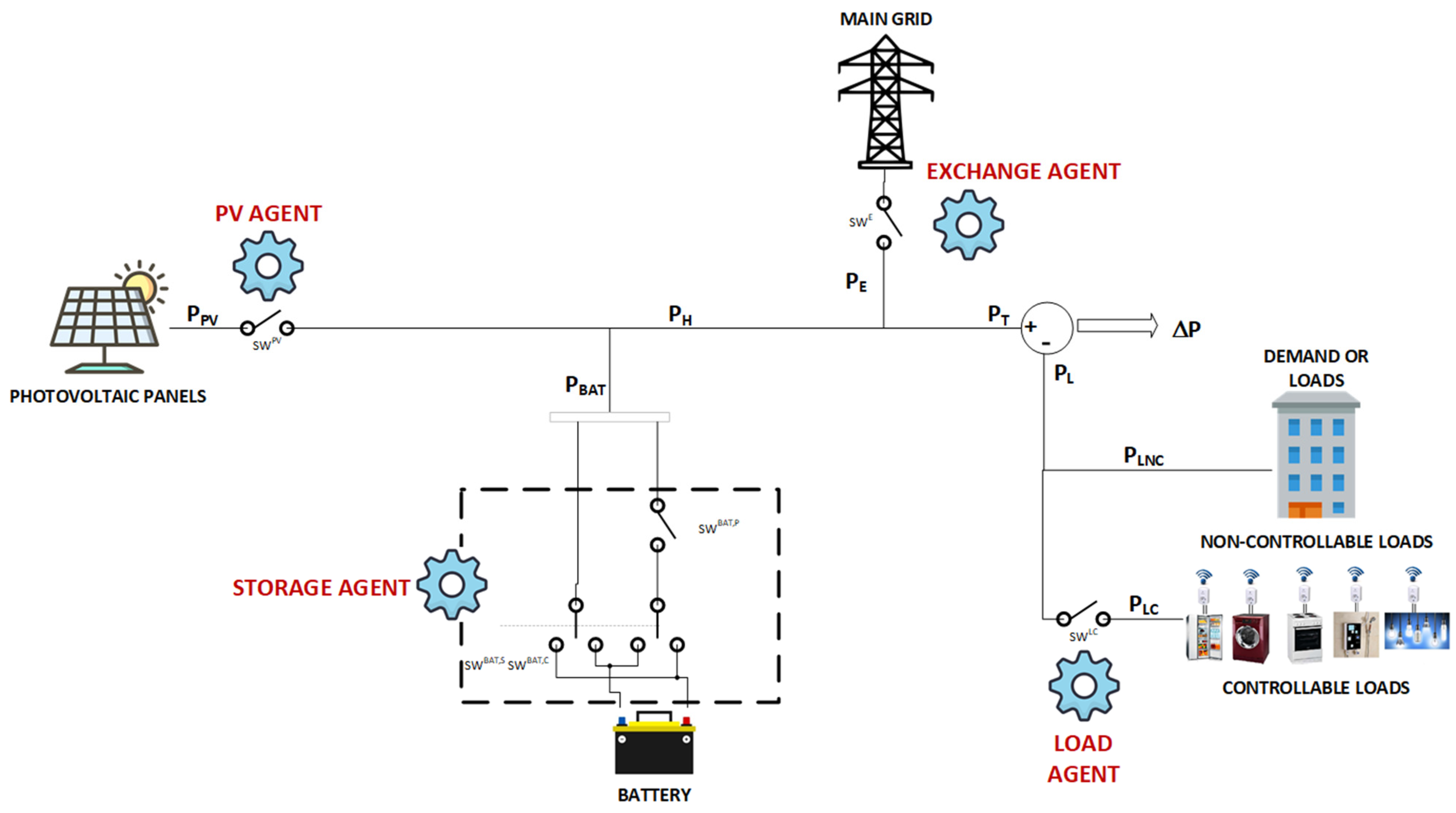
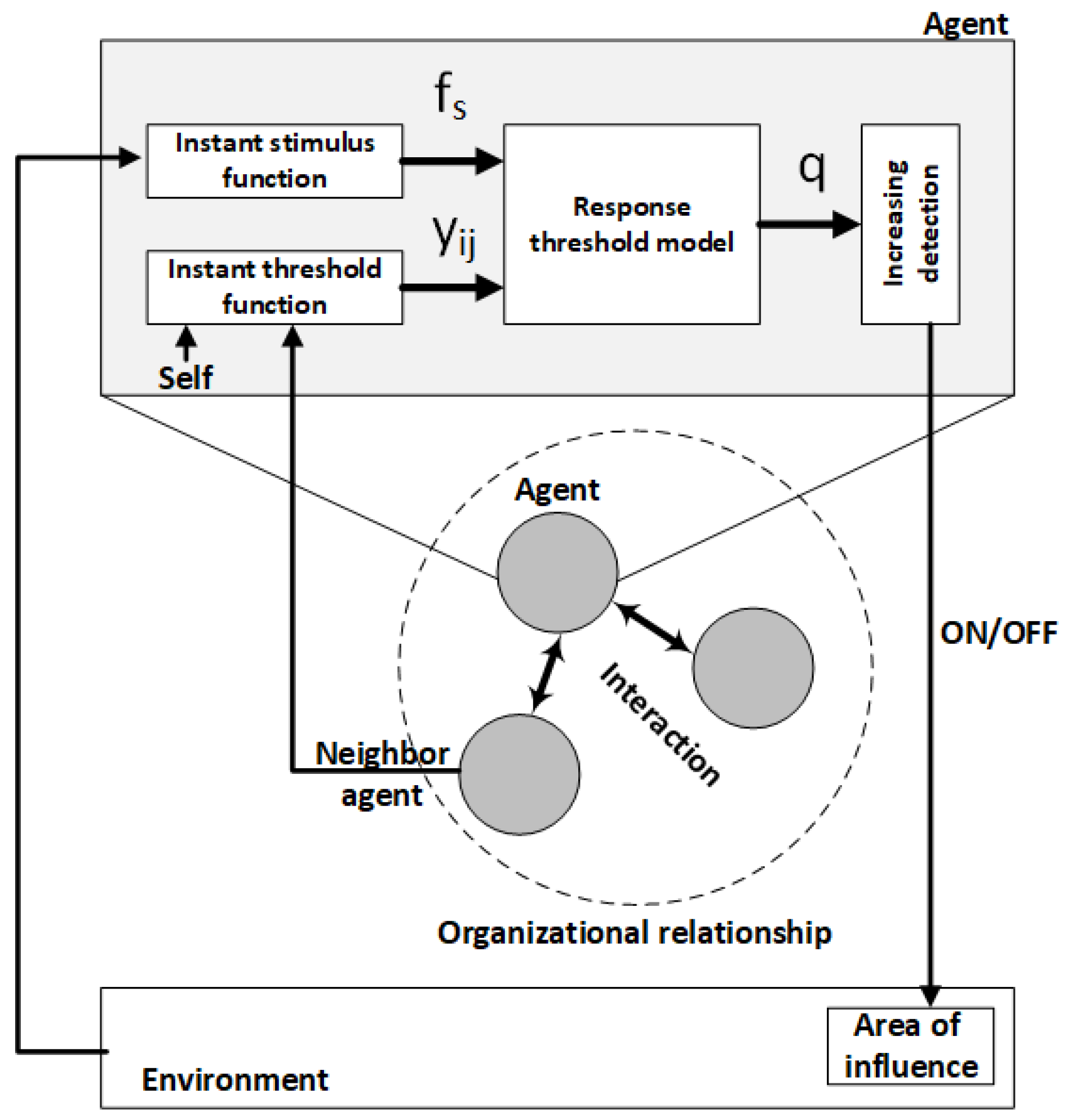
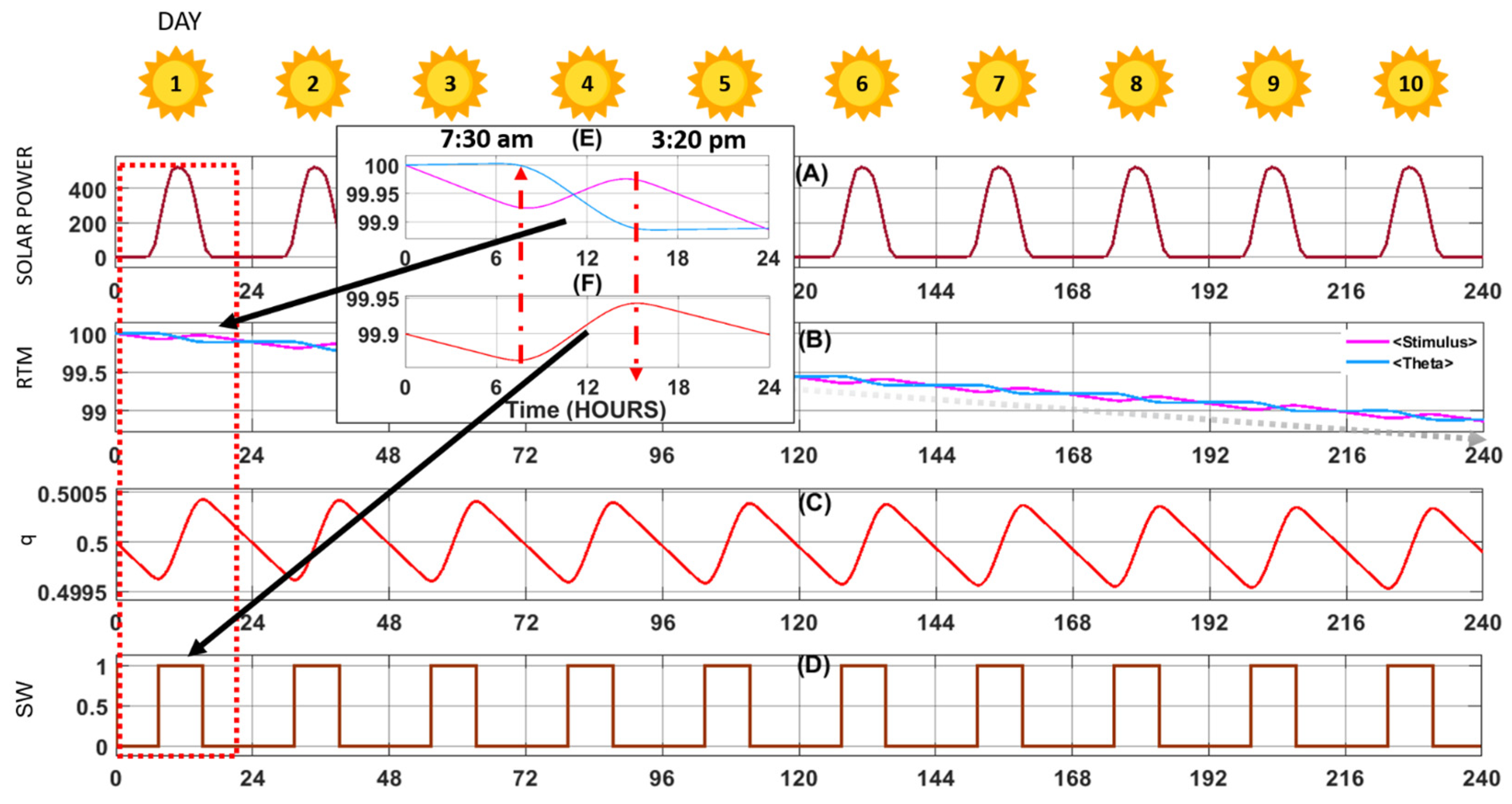
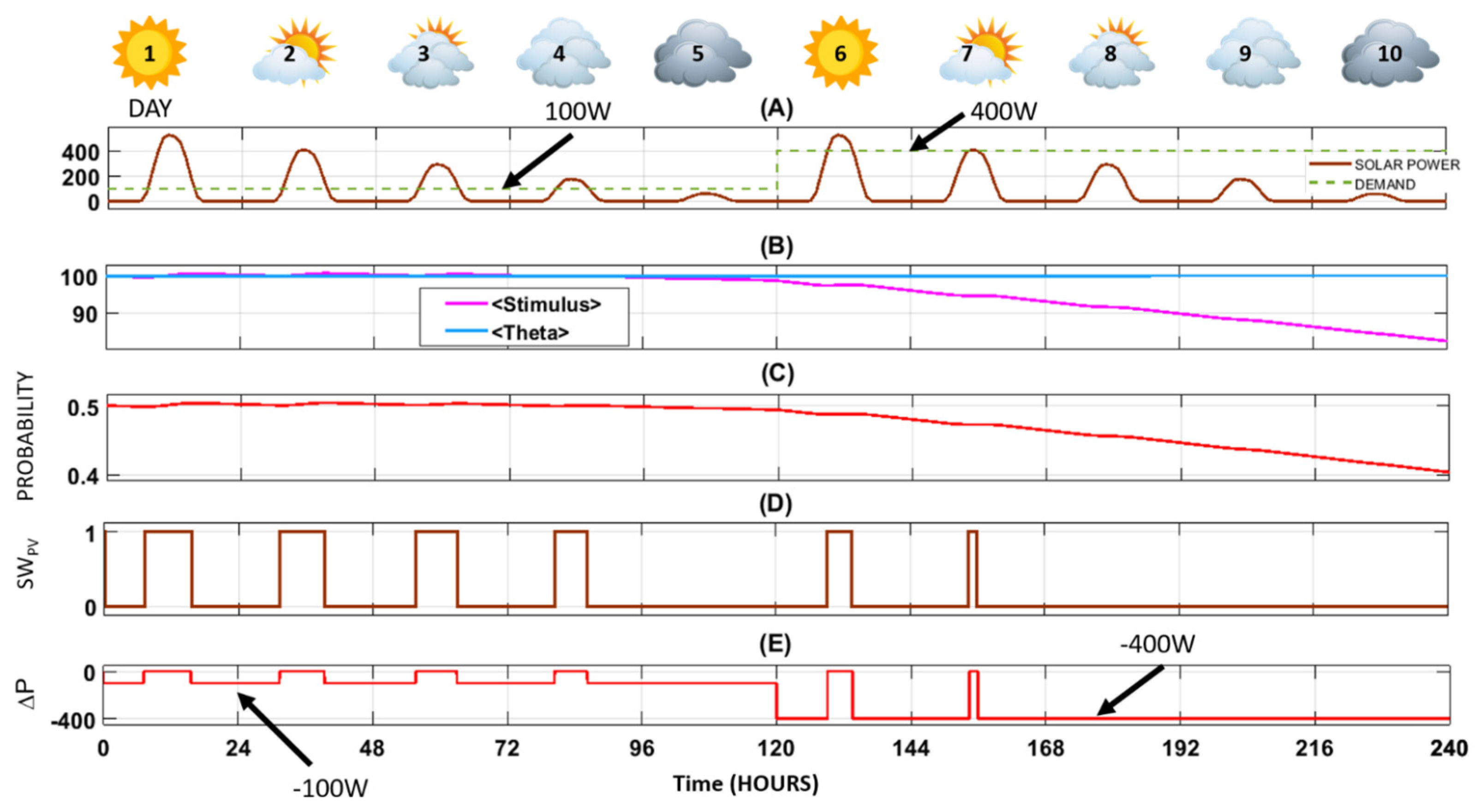
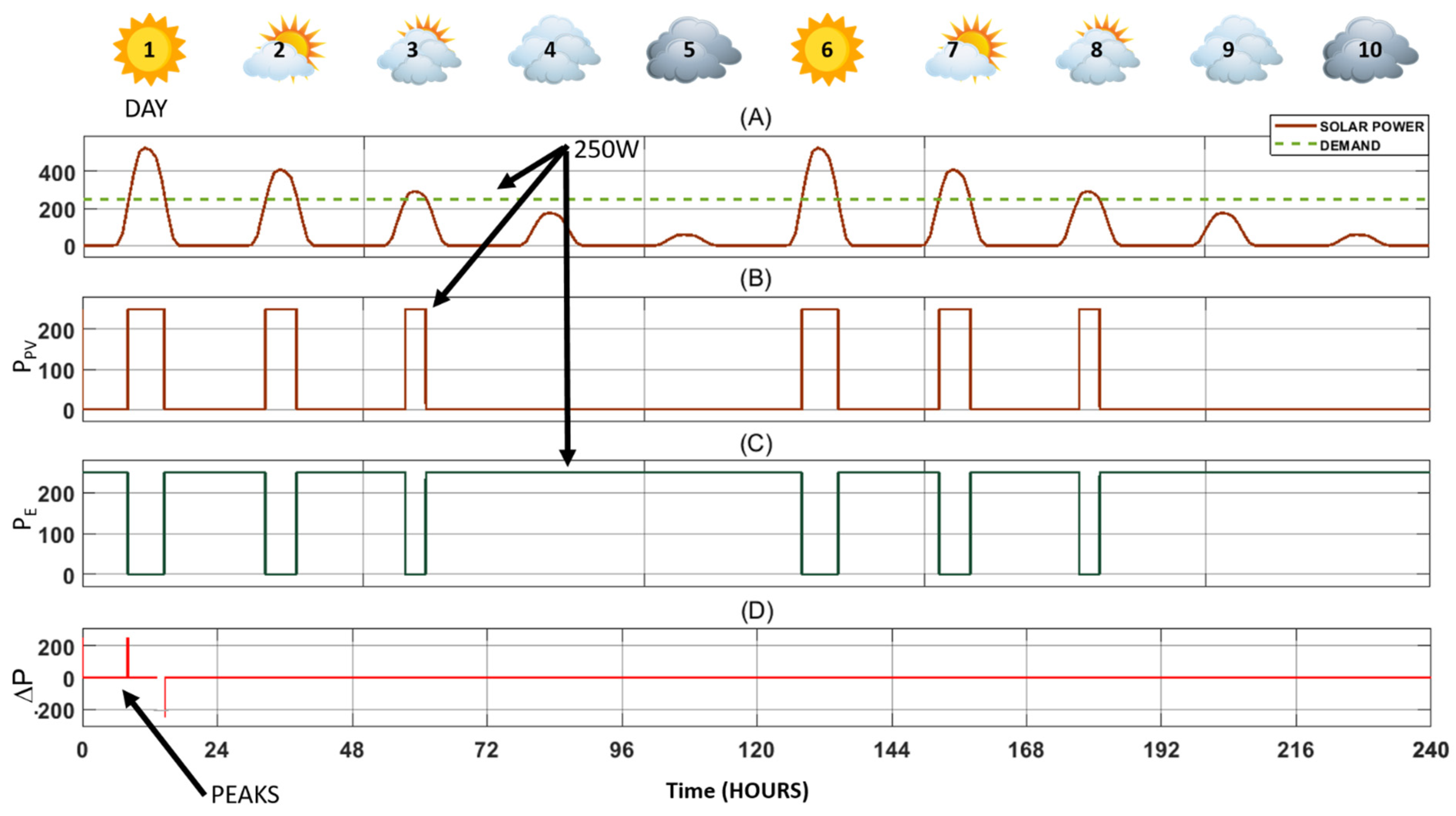
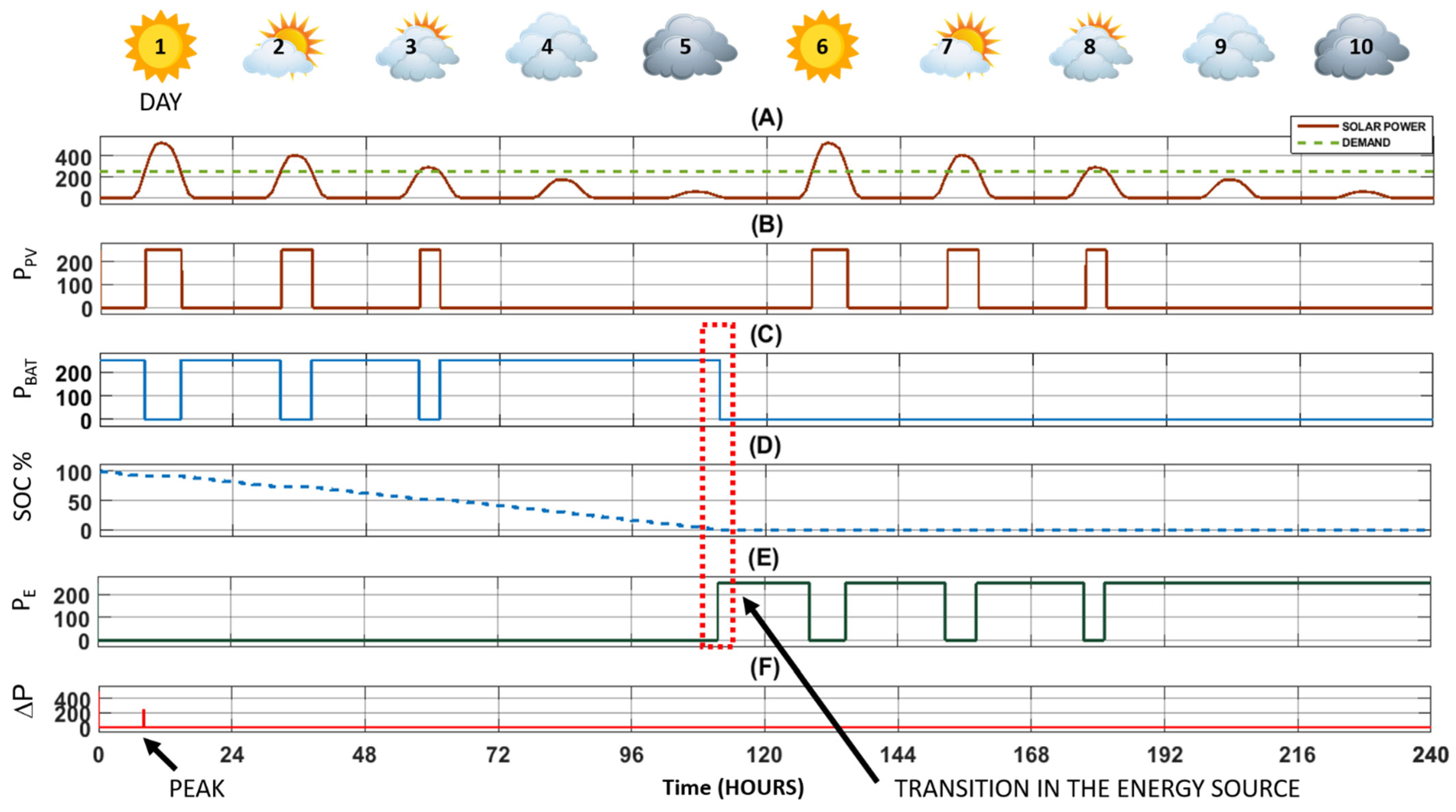
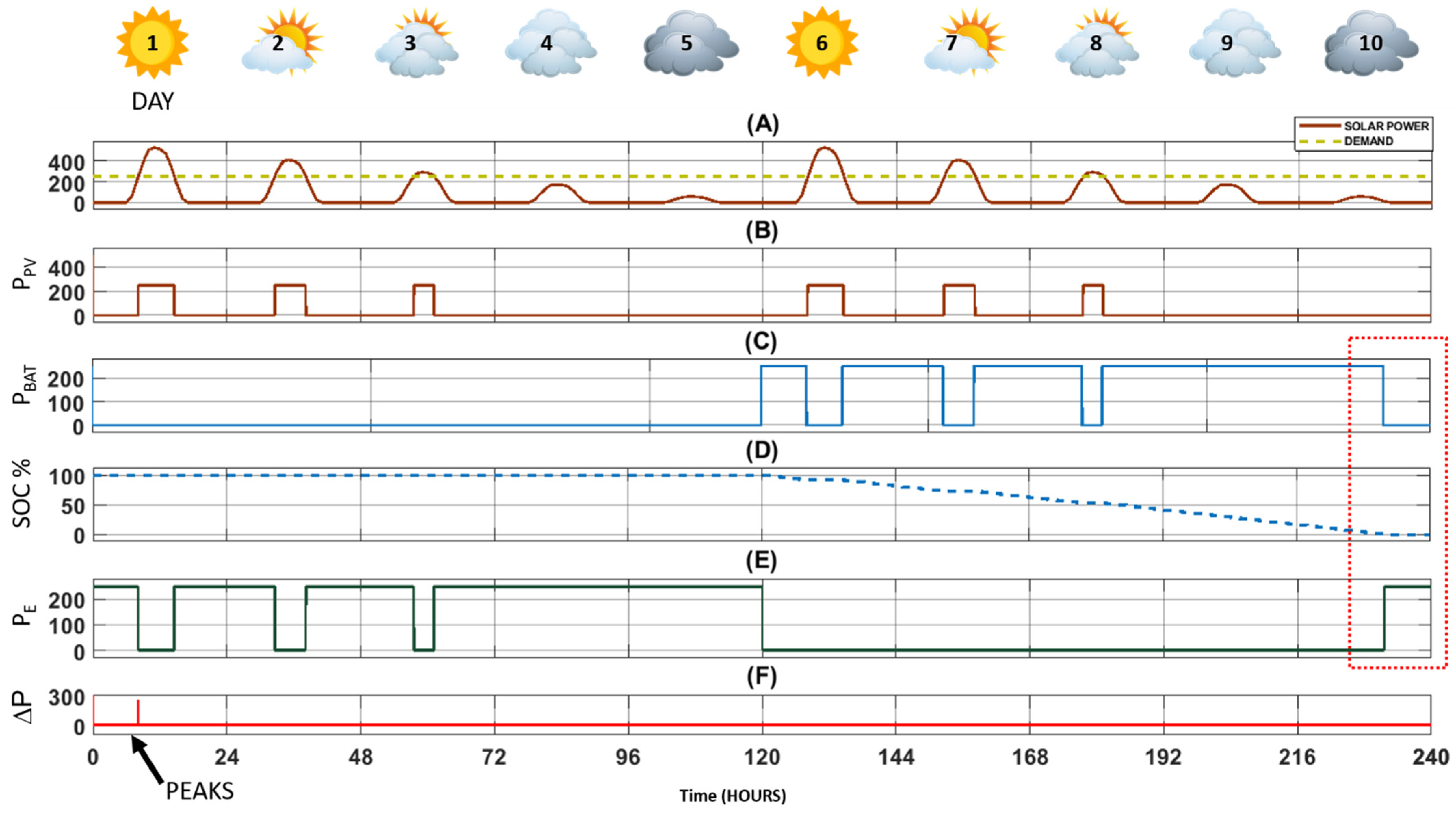
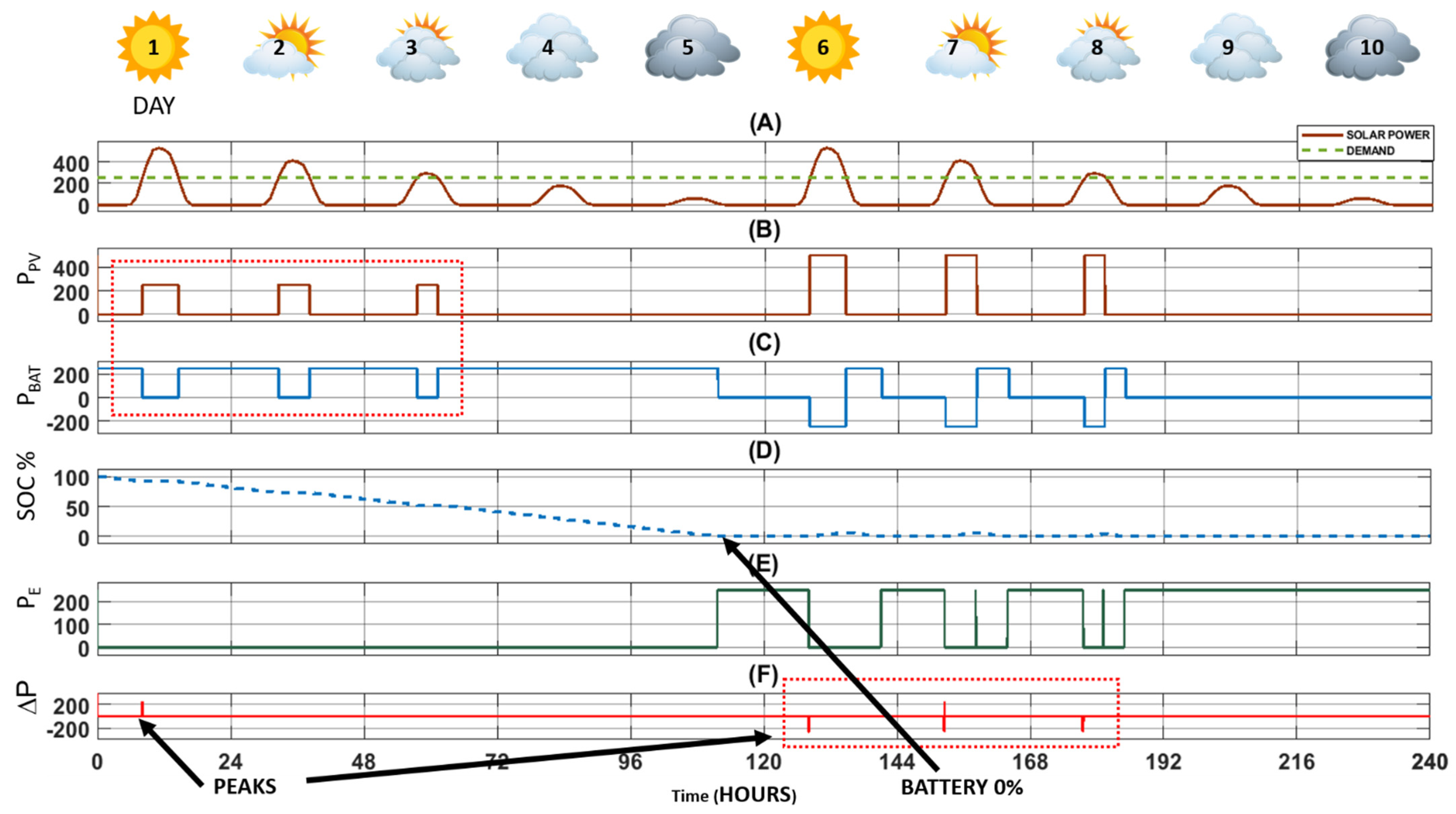
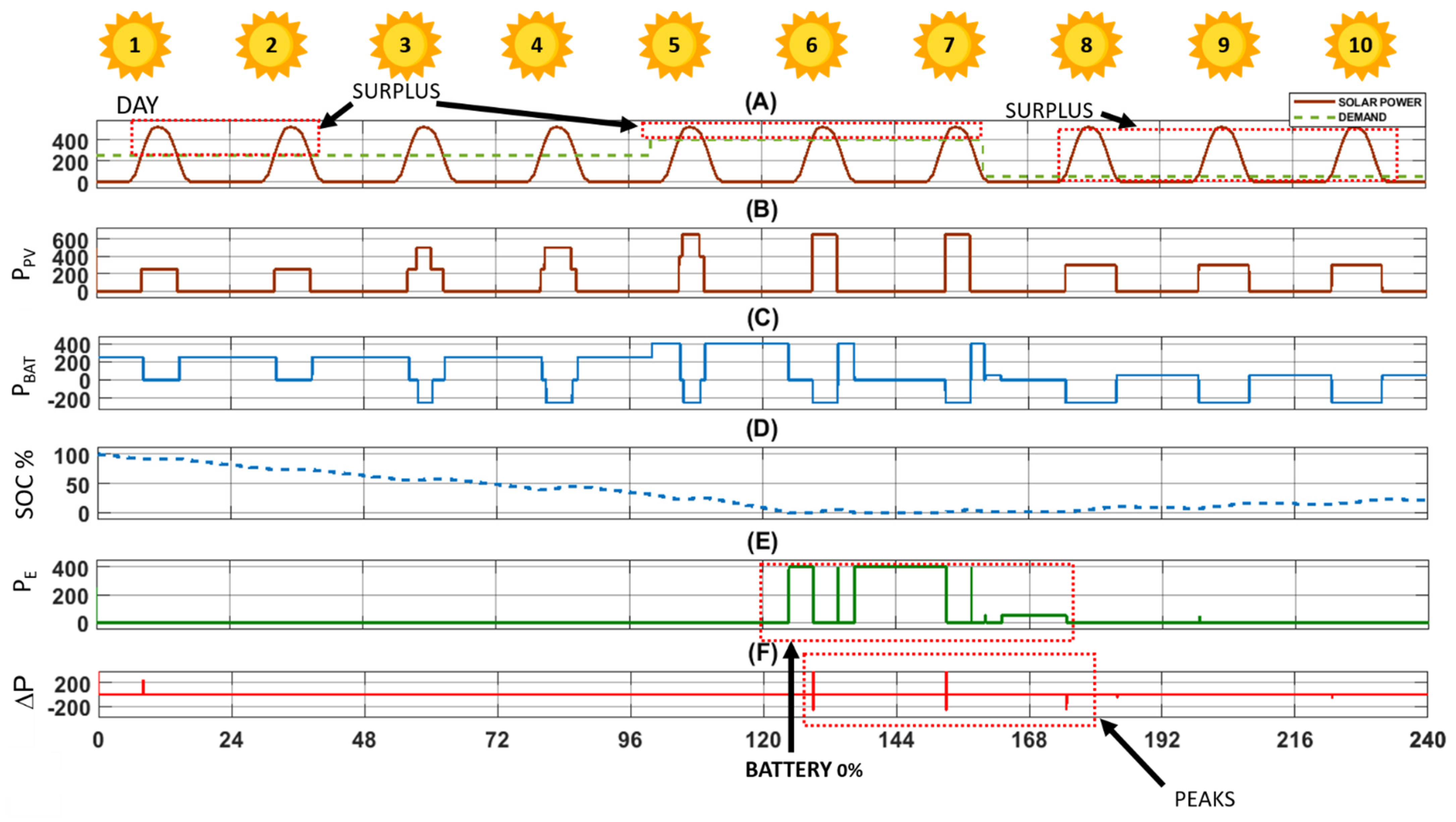
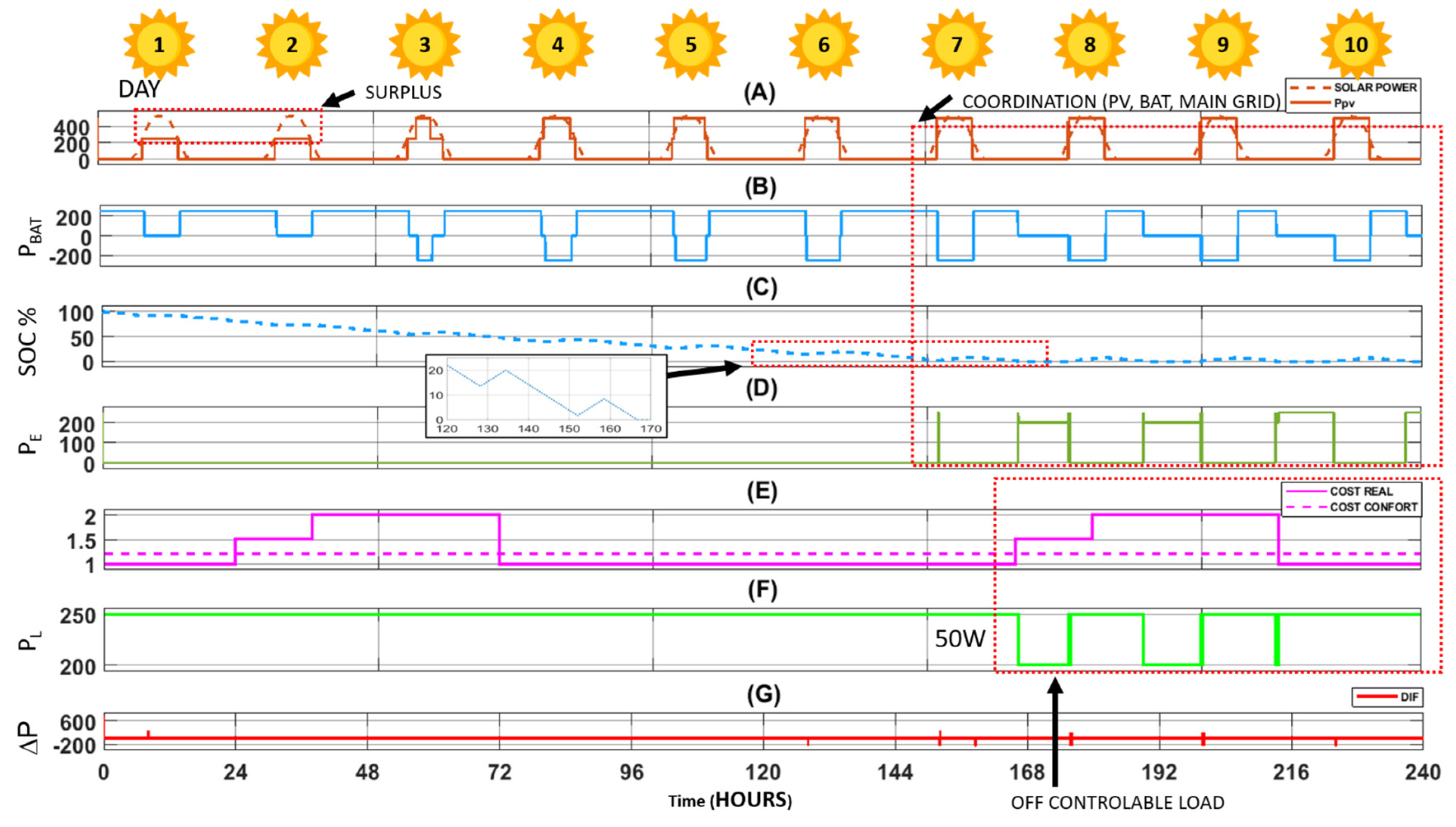
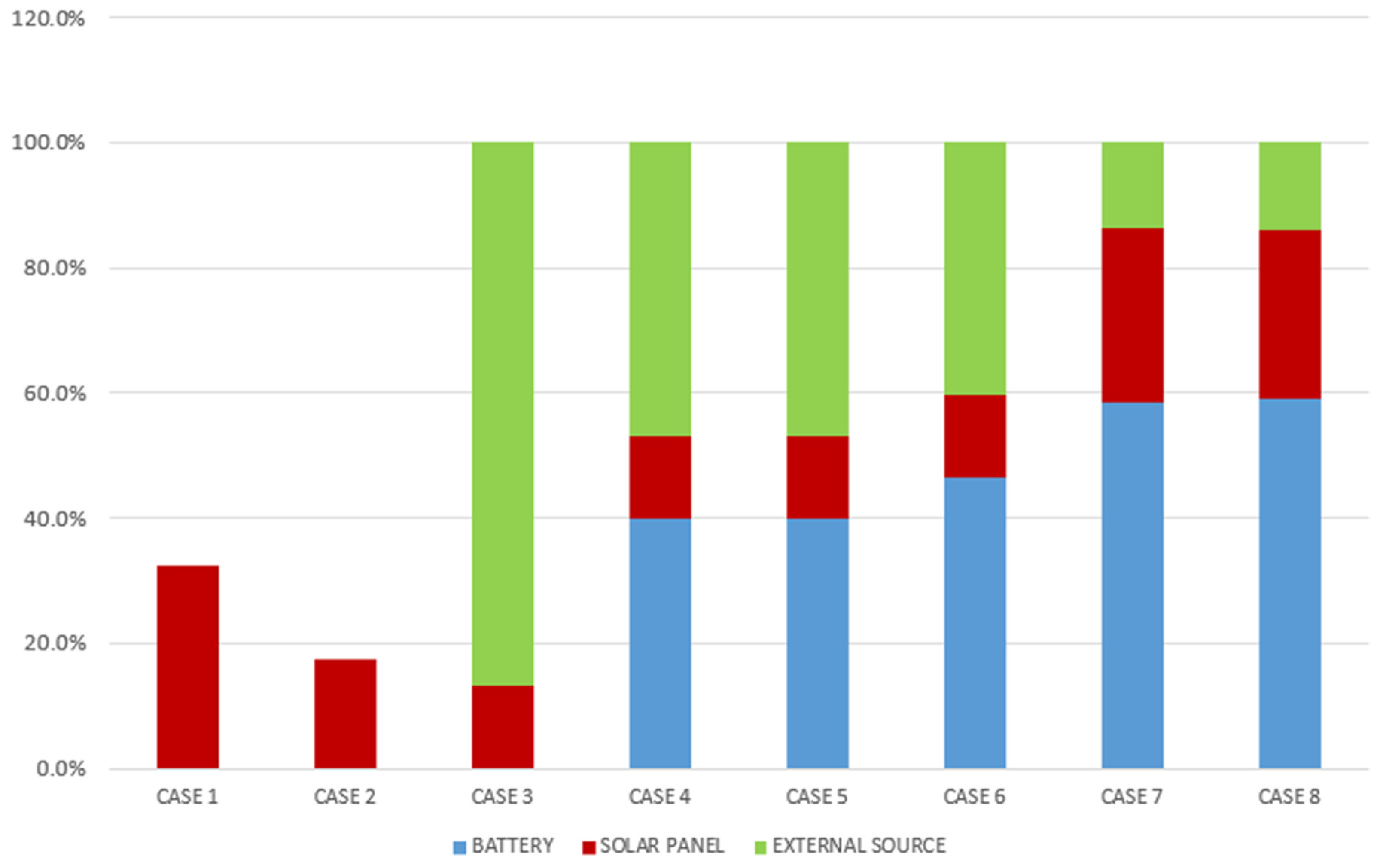
| Agent | Behavior | Environment | External Variables | Internal Variables or Parameters |
|---|---|---|---|---|
| Photovoltaic system |
| Solar radiation Weather conditions | Demand | Conversion efficiency Solar panel area |
| ESS |
| Renewable sources Demand | SOC | |
| Utility grid |
| Renewable sources SOC Demand | ||
| Controllable load |
| Renewable sources Demand Market cost | Comfort cost |
| Agent | ||
|---|---|---|
| Photovoltaic system | ||
| Battery | Producer: Consumer: | Producer: Consumer: |
| Utility grid | ||
| Controllable load |
| Metrics | % | S | ||
|---|---|---|---|---|
| ISE | 1.01 × 107 | 1.5 × 107 | 67.47% | 0.0 |
| IAE | 4.03 × 104 | 6 × 104 | 67.17% | 0.0 |
| Parameter | Symbol | PV Agent | Battery Agent Producer | Battery Agent Consumer | Exchange Agent | Load Agent |
|---|---|---|---|---|---|---|
| Initial stimulus si | 100 | 100 | 100 | 100 | 100 | |
| Initial response threshold | 100 | 100 | 100 | 100 | 100 | |
| Attenuation factor | w | 10.1 × 10−6 | 0.005 | 5 × 10−8 | 5 × 10−8 | 5 × 10−8 |
| Learning factor | 1.06 × 10−6 | 1 × 10−6 | 1 × 10−6 | 1 × 10−6 | 1 × 10−6 | |
| Forgetting factor | 3 × 10−5 | 3.9 × 10−5 | 3.9 × 10−5 | 3.9 × 10−5 | 3.9 × 10−5 |
| Metrics | % | S | ||
|---|---|---|---|---|
| ISE | 1.40 × 107 | 1.5 × 107 | 93.33% | 0.0 |
| IAE | 4.56 × 104 | 5.52 × 104 | 82.6% | 0.0 |
| Metrics | % | S | ||
|---|---|---|---|---|
| ISE | 1513 | 1.5 × 107 | 0.01% | 0.0 |
| IAE | 6.05 | 6 × 104 | 0.01% | 0.0 |
| Metrics | % | S | ||
|---|---|---|---|---|
| ISE | 6013 | 1.5 × 107 | 0.04% | 0.0 |
| IAE | 12.05 | 6 × 104 | 0.02% | 0.0 |
| Metrics | % | S | ||
|---|---|---|---|---|
| ISE | 1.35 × 104 | 1.5 × 107 | 0.09% | 0.0 |
| IAE | 18.05 | 6 × 104 | 0.03% | 0.0 |
| Metrics | % | S | ||
|---|---|---|---|---|
| ISE | 2.328 × 104 | 1.5 × 107 | 0.16% | 0.0 |
| IAE | 57.11 | 6 × 104 | 0.09% | 0.0 |
| Metrics | % | S | ||
|---|---|---|---|---|
| ISE | 2.84 × 104 | 1.5 × 107 | 0.19% | 0.0 |
| IAE | 73.26 | 6 × 104 | 0.73% | 0.0 |
| Metrics | % | S | ||
|---|---|---|---|---|
| ISE | 2.54 × 104 | 1.5 × 107 | 0.17% | 0.0 |
| IAE | 66.53 | 6 × 104 | 0.10% | 0.0 |
| Case 1 | Case 2 | Case 3 | Case 4 | Case 5 | Case 6 | Case 7 | Case 8 | ||
|---|---|---|---|---|---|---|---|---|---|
| PPV | Hours | 78.02 | 41.75 | 31.52 | 31.5 | 31.52 | 31.47 | 67 | 65.17 |
| Day | 3.25 | 1.74 | 1.31 | 1.31 | 1.31 | 1.31 | 2.79 | 2.72 | |
| % | 32.51% | 17.40% | 13.13% | 13.13% | 13.13% | 13.11% | 27.92% | 27.15% | |
| PBAT,S | Hours | 0 | 0 | 0 | 95.87 | 95.86 | 111.8 | 140.1 | 141.4 |
| Day | 0.00 | 0.00 | 0.00 | 3.99 | 3.99 | 4.66 | 5.84 | 5.89 | |
| % | 0.00% | 0.00% | 0.00% | 39.95% | 39.94% | 46.58% | 58.38% | 58.92% | |
| PE | Hours | 0 | 0 | 208.5 | 112.7 | 112.7 | 96.75 | 32.93 | 33.5 |
| Day | 0.00 | 0.00 | 8.69 | 4.70 | 4.70 | 4.03 | 1.37 | 1.40 | |
| % | 0.00% | 0.00% | 86.88% | 46.96% | 46.96% | 40.31% | 13.72% | 13.96% |
Disclaimer/Publisher’s Note: The statements, opinions and data contained in all publications are solely those of the individual author(s) and contributor(s) and not of MDPI and/or the editor(s). MDPI and/or the editor(s) disclaim responsibility for any injury to people or property resulting from any ideas, methods, instructions or products referred to in the content. |
© 2024 by the authors. Licensee MDPI, Basel, Switzerland. This article is an open access article distributed under the terms and conditions of the Creative Commons Attribution (CC BY) license (https://creativecommons.org/licenses/by/4.0/).
Share and Cite
García, M.; Aguilar, J.; R-Moreno, M.D. An Autonomous Distributed Coordination Strategy for Sustainable Consumption in a Microgrid Based on a Bio-Inspired Approach. Energies 2024, 17, 757. https://doi.org/10.3390/en17030757
García M, Aguilar J, R-Moreno MD. An Autonomous Distributed Coordination Strategy for Sustainable Consumption in a Microgrid Based on a Bio-Inspired Approach. Energies. 2024; 17(3):757. https://doi.org/10.3390/en17030757
Chicago/Turabian StyleGarcía, Marcel, Jose Aguilar, and María D. R-Moreno. 2024. "An Autonomous Distributed Coordination Strategy for Sustainable Consumption in a Microgrid Based on a Bio-Inspired Approach" Energies 17, no. 3: 757. https://doi.org/10.3390/en17030757
APA StyleGarcía, M., Aguilar, J., & R-Moreno, M. D. (2024). An Autonomous Distributed Coordination Strategy for Sustainable Consumption in a Microgrid Based on a Bio-Inspired Approach. Energies, 17(3), 757. https://doi.org/10.3390/en17030757








